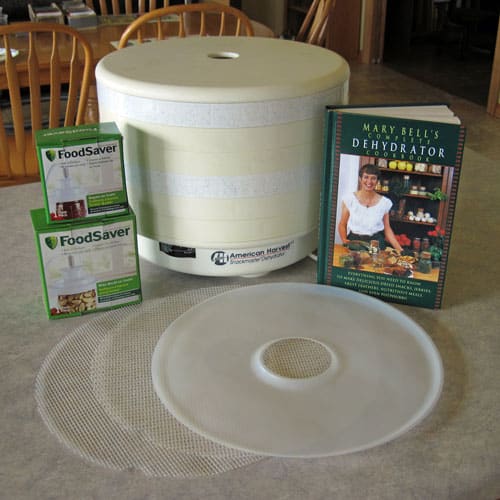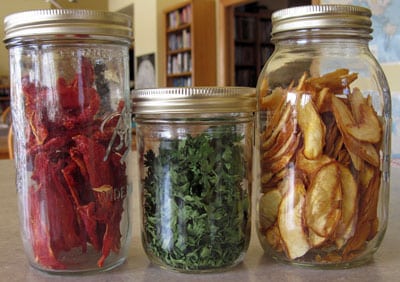Want an easy way to store and preserve food? Need a food storage method that doesn’t take up much space and requires very little equipment? Want to make healthier snacks for your family to enjoy at home or on the go? Looking for portable food for camping or backpacking? If you answered “yes” to any of these questions, you should learn about home food drying.
What Equipment Do I Need to Dehydrate Food at Home?
To dehydrate food, you need a dehydrator or drying area/rack. An oven can be used if you can set the temperature low enough, but it will use more energy than a commercial dehydrator or other home constructed options (see bottom of post for links to build your own dehydrator). As long as your humidity isn’t too high, you may be able to air dry (think herb bundles hung from rafters). Some folks rig up trays with covers (see one example here) and hang them near a heat sources such as a wood stove.Commercial dehydrators will give more consistent results and be easier to work with, giving you a better quality end product. Quick and uniform drying preserves color, flavor and texture. Most commercial units also allow you to set your temperature, which is very helpful for optimal drying of different foods. For instance, herbs are best dried at lower temperatures so that you don’t drive off volatile oils, while meats are typically dried at higher temps. If you purchase a commercial dehydrator, I highly recommend including the accessory sheets for fruits leather and fine mesh sheets in your purchase. They are so much easier to work with than improvised homemade options.
A sharp knife and cutting board is helpful for cutting fruits and vegetables into thinner pieces that will dry more quickly and evenly (a mandolin or food processor for cutting may be helpful in some cases, but isn’t absolutely necessary).
A good sized, heavy duty pot is helpful for cooking down fruits and blanching fruits and veggies. For purees and “leathers”, you’ll need a blender or food processor. I like using my salad spinner to predry herbs before loading them into the dehydrator. That’s enough equipment to get you started, although some specialty items such as cherry pitters and apples corers may come in handy once you get rolling.
What Types of Food Can be Dried?
Just about anything can be dried, from vegetables and fruit to meat and fish. Home dried herbs are a fraction of the cost of store bought herbs. Natural fruit leathers are also quite expensive in the store, and are one of the simplest things to make in your dehydrator. You can use your dehydrator to make snacks for people and pets. You can also use it to dehydrate excess kefir grains or sourdough starter.How do I prepare food for drying?
Generally, you want to slice or chop uniform pieces of food between 1/8 and 1/2 inch thick. Food that is too thick or irregularly shaped will lead to non-uniform drying, which could lead to spoilage or lower quality product.Pretreating – some foods are pre-treated before drying to help to preserve color and flavor. For instance, fruits can be dipped in saltwater, and acidic medium or something sweet to reduce oxidation. My favorite method is to use a couple of tablespoons of lemon juice in a bowel of water. Inexpensive, easy and doesn’t dramatically change the flavor of the fruit. Many people also enjoy dipping sliced fruit in other acidic fruit juices, such as apple or banana slices in pineapple or orange juice. More detailed information is linked below in specific posts.
Marinades are commonly used for meats such as jerkies to enhance flavor and improve shelf life. Blanching in water or steam helps slow down enzyme action and softens skins, making it each for moisture to be driven out and making the product more palatable when rehydrated. Many vegetables (but not all) are best blanched before dehydrating.
How long does it take to dry food?
It really depends on the food and the drying conditions – anywhere from a few hours to days, depending on what is being dried and how it is being dried. Thinner items dry faster than thick. Units with fans dry faster than units without fans. Natural drying can go pretty slowly, but still works well in many situations. Most of the time I load my dehydrator in the evening and let it dry overnight.How can I tell if home dehydrated food is dry enough?
Different foods will have different textures when dried, from brittle to leather-like to gummy. As you work with dehydrating, you’ll get a feeling for appropriate dryness. The texture of home dried foods is often different than commercially dried foods, so don’t let this put you off. Remember, you’re making your products without strange additives or deep frying or other commercial processes.A good rule of thumb to test dryness is to put the product in a tightly sealed jar, and check for condensation on the lid after about a day. If you’ve got condensation, you need to dry it more – it won’t keep – or put it in the freezer or refrigerator.
How do I store dried food and how long will it keep?
My preferred storage container is a standard or wide mouthed mason jar. If I have a lot of a product (enough to fill multiple jars), I’ll use the vacuum sealer attachment for my Foodsaver to seal most of the jars to extend shelf life even further. I keep the jars out of direct light (in the pantry), and/or cover them with sock cozies. You can also use plastic bags or plastic jars, or glass jars from other commercial products.Storage life depends on conditions. Dried food has been found on archeological digs that was still technically “edible”, but definitely not a yummy. Dried produce and herbs should last around a year (from one season to the next) if properly stored. I’ve kept items longer, but flavor, color and nutrients diminish over time.
Do you dry food at home? What technique/equipment do you use?
Below is an assortment of links from my blog and other other online resources to help you get started with dehydrating.
Common Sense Homesteading Posts on Food Drying
Preserving Asparagus Three Ways – Freezing, Drying and LactofermentingPeeling, Canning and Drying Peaches
Preserving Strawberries Four Ways – Freezing, Drying, Fruit Leather and Kombucha
Making Applesauce, Apple leather and Dried Apple Slices
Pumpkin Leather
Ground Beef Jerky
Crispy Nuts and Maple Candied Walnuts
Drying Herbs
Online Resources for Home Food Dehydrating
Facebook group – Dehydrating Way Beyond JerkyNational Center for Home Food Preservation – How Do I Dry Foods?
Dehydrate2Store.com – “On this site you will learn to build your pantry for long term food storage, cook fast and simple meals with prepackaged foods, store food for years and re-hydrate it back to new! Also you will find instructional videos, delicious recipes using dehydrated foods, helpful hints, important information, and great ideas.”
NESCO/American Harvest How To Dehydrate Guides
Home Food Dehydrators You Can Make Yourself
DIY Electric Dehydrators
Living Foods Dehydrators – Wooden dehydrators made in the USA, or buy the kit and make your own.DIY Dehydrator made with a box fan – Alton Brown’s box fan dehydrator made with a box fan, cellulose furnace filters and a bungie cord or two.
Home made dehydrator made with plywood – Do it yourself dehydrator instructions for a box dehydrator made with plywood, and incandescent lightbulb and recycled refrigerator racks.
The $10 Jerky Maker – Quick and easy instructions for a box dehydrator using a cardboard shipping box, a light bulb, and PVC pipe. Detailed instructions, lots of photos.
Do-if yourself food dehydrator/jerky maker – DIY dehydrator instructions to build a unit with a cardboard box, light bulb, cooling racks and metal skewers. I like this a little better than the PVC option because the parts touching the food are food grade materials. Nice photos.
DIY Solar Dehydrators
Build It Solar – Solar Cooking and Food Drying - 10 different solar food dehydrator designsSolar Fruit Dryer – PDF plans for a large solar fruit dryer



Nice write up.
ReplyDeleteYou covered very useful information related to food dehydrators. I have a blog related to dehydrator. I usually cover food dehydrators reviews, tips and guidesin that site.